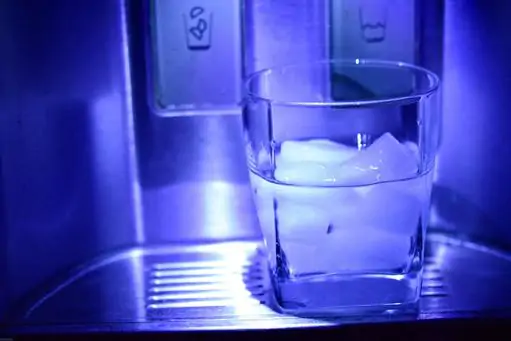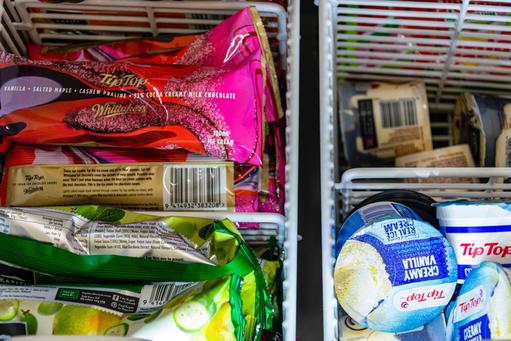A GE bottom freezer ice build-up is an indication that one or more parts have failed. The most common cause of this problem is a build-up of ice in the bottom freezer. This can be caused by several factors, including a faulty door seal, a clogged defrost drain, or a build-up of frost on the evaporator coils. If you have this problem, there are a few things you can do to fix it easily. Let’s discuss ge bottom freezer ice build-up.
First, check the door seal to make sure it is tight and free of any gaps. Next, clear the defrost drain and make sure it is not clogged. Finally, clean the evaporator coils to remove any frost build-up. If these steps do not fix the problem, you may need to replace one or more parts.
Icing up Of The Refrigerator – Remedies
1. Make Sure The Temperature Is Correct
If your GE refrigerator is icing up, it could be a result of low temperature. Take a look at the temperature setting. The setting should be 5 and 5 or C and 5 for models with control knobs. If the setting is too low, the ice will build up. You can try turning the temperature up a bit and see if that helps. If not, you may need to call a repairman to take a look at it.
In the meantime, you can try defrosting the fridge manually by unplugging it and letting all the ice melt. Then, clean it out thoroughly before plugging it back in and resetting the temperature.
2. Check the Door Seal
If there is sub-zero freezer ice build-up, it’s probably time to replace the door seal. Closing the door on a piece of paper or a dollar bill is a fast and simple method to see if your refrigerator door seal needs to be replaced. If the paper or bill can be pulled out from under the door because the seal isn’t sealing properly, it needs to be replaced.
The seal does not need to be replaced if the paper or bill is trapped in position. Of course, if you’re unsure, it’s always a good idea to get advice from a professional. However, this simple check may provide you with an indication as to whether or not your refrigerator door seal needs to be replaced.
3. Verify the Damper Control
If your GE bottom freezer is having trouble with ice buildup, there are a few things you may try. To begin, remove the fresh food compartment’s shelves. Then, locate the air duct at the back of the compartment and remove it. Finally, thaw any ice that has accumulated on the coils using a hairdryer.
Once the coils are thawed, you can put everything back together and see if that solves the problem. If not, you may need to replace the gasket around the door or call a repairman to take a look. Either way, getting rid of ice build-up in your bottom freezer is a relatively easy task that you should be able to handle on your own.
4. Check the Thermistor
If your ge bottom freezer begins to ice up, check the thermistor for functionality. The resistance of the thermistor can be measured with a multimeter as the refrigerator temperature changes, and it should change accordingly.
If the thermistor is faulty, it might be causing the ice to form. To prevent this, check the thermistor regularly and replace it if necessary. You can maintain your ge bottom freezer in excellent working order for years with a little bit of diligence.
5. Look At The Defrost System
Ice can build up in a GE bottom freezer refrigerator’s defrost system for a variety of reasons. The most prevalent offender is the defrost system. The defrost timer, defrost heater, defrost thermostat, and ice buildup on coils are all components of the system. If any of these elements aren’t operating appropriately, ice may accumulate on the coils.
You’ll need to inspect each component in the system as part of your troubleshooting. The defrost timer is a good place to start. If it doesn’t advance, the defrost heater will have to be replaced. Check next to the defrost heater. If it isn’t warming up, it will have to be replaced. Finally, check the defrost thermostat and temperature sensor. If either of these components is not functioning properly, they will have to be changed.
7. Examine The Condenser Coils
When ice builds up and prevents the refrigerator door from closing properly, it’s a major annoyance. Not only is this an inconvenience, but it can also cause the fridge to work less effectively, resulting in higher energy costs. The good news is that cleaning the condenser coils on most refrigerators usually solves the problem. The condenser coils are located behind or beneath most fridges, and they aid in heat release.
It’s important to wash your refrigerator coils regularly since dust and other pollutants can build upon them over time, preventing them from functioning properly. As a result, ice begins to accumulate inside the fridge. To clean the coils, simply unplug the refrigerator and wipe it down with a cloth or a condenser brush. After they’re clean, plug them back in and see if the ice accumulation has gone away. Taking this simple step can ensure that your refrigerator works well for years to come.
7. Check the Content
Ice build-up on the bottom of a freezer can slow down its operation and cause you to spend more money in the long term. To avoid this, make sure there is at least ¾ of an inch of space between the top of your unit and the ceiling. This will allow air to flow freely and prevent ice from forming.
You should also avoid placing things too close to the unit’s edges, as this may restrict airflow and cause the compressor to operate more. If your freezer is less than ¾ full, try using smaller items or adding extra insulation to make up for the difference. You can help keep your ge bottom freezer ice build-up-free and operational for years by following these straightforward suggestions.
9. Examine the Position
Ice build-up is a frequent problem with GE bottom-freezer refrigerators. Ice may form if your refrigerator is icing up for a variety of reasons. Check the location first. If it’s too close to any sort of heat sources, such as an oven or a radiator, move it away. If it’s in the way of direct sunlight, either one
Second, make sure the door seals are sound and that the gasket is clean. A damaged or dirty seal might allow warm air to enter the fridge, causing ice to form. Finally, check your air filter for obstructions. A clogged air filter can limit airflow and cause the evaporator coils to frost over as a result of restricted flow. If you’ve done everything and the problem persists, you may need to call a service professional. Fortunately, most ice build-up problems are simple to solve with a little effort.


